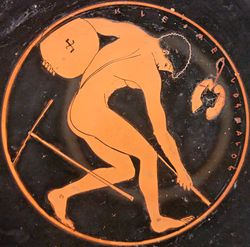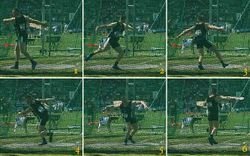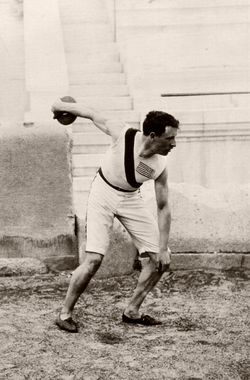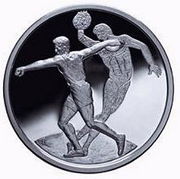Discus throw

The discus throw (pronunciation) is an event in track and field athletics competition, in which an athlete throws a heavy disc — called a discus — in an attempt to mark a farther distance than his or her competitors. It is an ancient sport, as evidenced by the 5th century BC Myron statue, Discobolus. Although not part of the modern pentathlon, it was one of the events of the ancient pentathlon, which can be dated at least back to 708 BC.[1]
The discus throw is a routine part of most modern track and field meets at all levels and is a sport which is particularly iconic of the Olympic Games. The men's competition has been a part of the modern Summer Olympic Games since the first Olympiad in 1896. Images of discus throwers figured prominently in advertising for early modern Games, such as fundraising stamps for the 1896 games[2] and the main posters for the 1920 and 1948 Summer Olympics.[3]
The women's competition was added to the Olympic program in the 1928 games, although they had been competing at some national and regional levels previously.
Contents |
Description

The discus, the object to be thrown, is a heavy lenticular disc with a weight of 2 kilograms (4 lb 7 oz) and diameter of 220 mm (8.66 inches) for the men's event, and a weight of 1 kg (2 lb 3 oz) and diameter of 181 mm (7.17 inches) for the women's event. In U.S. high school track and field, boys typically throw a discus weighing 1.616 kg (3 lb 9 oz) and the girls throw the 1 kg (2.2 lb) women's discus. The discus can be thrown starting at age 11 (midget division). Most children throw the 1 kg discus. The discus usually has sides made of rubber, plastic, wood, or metal with a metal rim and a metal core to attain the weight. A discus with more weight in the rim produces greater angular momentum for any given spin rate, and thus more stability, although it is more difficult to throw. A practice discus made of solid rubber is often used in High School; it is cheaper, more durable, and easier to learn to throw (due to its more equal distribution of weight, as opposed to the heavy rim weight of the metal rim/core discus).
To make a throw, the competitor starts in a slightly recessed concrete-surfaced circle of 2.5 metres (8 feet 2½ inches) diameter. The thrower typically takes an initial stance facing away from the direction of the throw. He then spins counter-clockwise (for right-handers) around one and a half times through the circle to build momentum, then releases his throw. The discus must land within a 34.92-degree arc marked by lines on the landing zone, and the competitor must not exit the circle until the discus has landed, then must wait for the judge to give clearance to exit the ring from the rear half. The distance from the front edge of the circle to where the discus has landed is measured, and distances are rounded down to the nearest centimetre or half-inch. The competitor's best throw from the allocated number of throws, typically three to six, is recorded, and the competitor who legally throws the discus the farthest is declared the winner. Ties are broken by determining which thrower has the longer second-best throw.
The basic motion is a forehanded sidearm movement. The discus is spun off the index finger or the middle finger of the throwing hand. In flight the disc spins clockwise when viewed from above for a right-handed thrower, and counter-clockwise for a lefty. As well as achieving maximum momentum in the discus on throwing, the discus' distance is also determined by the trajectory the thrower imparts, as well as the aerodynamic behavior of the discus. Generally, throws into a moderate headwind achieve the maximum distance. Also, a faster-spinning discus imparts greater gyroscopic stability. The technique of discus throwing is quite difficult to master and needs lots of experience to get right, thus most top throwers are thirty years old or more.
Phases of the throw

There are six keys movements of the discus throw: wind up, move in rhythm, balance, right leg engine, orbit, and delivery. The wind up is one of the most important aspects of the throw because it sets the tone for the entire throw. The wind up is both mental and technical. It is mental because the wind up sets you up for the rest of the throw. The following are the technical aspects: flat right foot, on the ball of your left foot, keep your weight evenly distributed between your feet, and do not over do it (being overly active can result in the waste of energy). Although the wind up sets the tone for the entire throw, the rhythm of the throw is the most important aspect. It is necessary to move in rhythm through out the entire throw. The best throwers contain the same amount of time in each phase while completing a great throw. Focusing on rhythm can bring about the consistency to get in the right positions that many throwers lack. Executing a sound discus throw with solid technique requires perfect balance. This is due to the throw being a linear movement combined with a one and a half rotation and an implement at the end of one arm. Thus, a good discus thrower needs to maintain balance within the circle.
Top ten performers



Accurate as of July 2010.[4][5]
Men
| Mark | Athlete | Venue | Date |
|---|---|---|---|
| 74.08 m (243 ft 0.5 in) | Neubrandenburg | June 6, 1986 | |
| 73.88 m (242 ft 4.7 in) | Kaunas | August 3, 2000 | |
| 73.38 m (240 ft 9 in) | Helsingborg | September 4, 2006 | |
| 71.86 m (235 ft 9.1 in) | Moscow | May 29, 1983 | |
| 71.70 m (235 ft 2.8 in) | Szombathely | July 14, 2002 | |
| 71.50 m (234 ft 7 in) | Wiesbaden | May 3, 1997 | |
| 71.32 m (233 ft 11.9 in) | Eugene | June 4, 1983 | |
| 71.26 m (233 ft 9.5 in) | San Jose | June 9, 1984 | |
| 71.26 m (233 ft 9.5 in) | Malmö | November 15, 1984 | |
| 71.26 m (233 ft 9.5 in) | San José, CA | May 25, 1985 |
Women
| Mark | Athlete | Venue | Date |
|---|---|---|---|
| 76.80 m (251 ft 11.6 in) | Neubrandenburg | July 9, 1988 | |
| 74.56 m (244 ft 7.4 in) | Nitra | August 26, 1984 | |
| 74.56 m (244 ft 7.4 in) | Neubrandenburg | July 23, 1989 | |
| 74.08 m (243 ft 0.5 in) | Karl-Marx-Stadt | June 20, 1987 | |
| 73.84 m (242 ft 3.1 in) | Bucharest | April 30, 1988 | |
| 73.36 m (240 ft 8.2 in) | Prague | August 17, 1984 | |
| 73.28 m (240 ft 5 in) | Donetsk | September 8, 1984 | |
| 73.23 m (240 ft 3.1 in) | Kazanlak | April 19, 1987 | |
| 73.10 m (239 ft 10 in) | Berlin | July 20, 1984 | |
| 72.92 m (239 ft 2.9 in) | Potsdam | August 20, 1987 |
World record progress
Men
| Mark | Athlete | Venue | Date |
|---|---|---|---|
| 47.58 m (156 ft 1.2 in) | New York | 1912-05-27 | |
| 47.61 m (156 ft 2.4 in) | Chicago | 1924-09-14 | |
| 47.89 m (157 ft 1.4 in) | San Francisco | 1925-05-02 | |
| 48.20 m (158 ft 1.6 in) | Palo Alto, California | 1926-04-02 | |
| 49.90 m (163 ft 8.6 in) | Palo Alto, California | 1929-03-09 | |
| 51.03 m (167 ft 5.1 in) | Palo Alto, California | 1930-05-17 | |
| 51.73 m (169 ft 8.6 in) | Pittsburgh, Pennsylvania | 1930-08-23 | |
| 52.42 m (171 ft 11.8 in) | Oslo | 1934-08-25 | |
| 53.10 m (174 ft 2.6 in) | Magdeburg, Germany | 1935-04-28 | |
| 53.26 m (174 ft 8.9 in) | Palo Alto, California | 1941-06-20 | |
| 53.34 m (175 ft 0 in) | Milan | 1941-10-26 | |
| 54.23 m (177 ft 11 in) | Milan | 1946-04-14 | |
| 54.93 m (180 ft 2.6 in) | Minneapolis, Minnesota | 1946-06-08 | |
| 55.33 m (181 ft 6.3 in) | Milan | 1948-10-10 | |
| 56.46 m (185 ft 2.8 in) | Lisbon | 1949-07-09 | |
| 56.97 m (186 ft 10.9 in) | Hämeenlinna, Finland | 1949-08-14 | |
| 57.93 m (190 ft 0.7 in) | Lincoln, Nebraska | 1953-06-20 | |
| 58.10 m (190 ft 7.4 in) | Pasadena, California | 1953-07-11 | |
| 59.28 m (194 ft 5.9 in) | Pasadena, California | 1953-08-22 | |
| 59.91 m (196 ft 6.7 in) | Warsaw | 1959-06-14 | |
| 59.91 m (196 ft 6.7 in) | Walnut, California | 1960-08-12 | |
| 60.56 m (198 ft 8.3 in) | Frankfurt | 1961-08-11 | |
| 60.72 m (199 ft 2.6 in) | Brussels | 1961-08-20 | |
| 61.10 m (200 ft 5.5 in) | Los Angeles | 1962-05-18 | |
| 61.64 m (202 ft 2.8 in) | Leningrad, USSR | 1962-06-04 | |
| 62.45 m (204 ft 10.7 in) | Chicago | 1962-07-01 | |
| 62.62 m (205 ft 5.4 in) | Walnut, California | 1963-04-27 | |
| 62.94 m (206 ft 6 in) | Walnut, California | 1964-04-25 | |
| 64.55 m (211 ft 9.3 in) | Turnov, Czechoslovakia | 1964-08-02 | |
| 65.22 m (213 ft 11.7 in) | Sokolov, Czechoslovakia | 1965-10-12 | |
| 66.54 m (218 ft 3.7 in) | Modesto, California | 1968-05-25 | |
| 68.40 m (224 ft 4.9 in) | Reno, Nevada | 1968-09-18 | |
| 68.40 m (224 ft 4.9 in) | Stockholm | 1972-07-05 | |
| 68.48 m (224 ft 8.1 in) | Stellenbosch, South Africa | 1975-03-14 | |
| 69.08 m (226 ft 7.7 in) | Long Beach, California | 1975-05-03 | |
| 69.18 m (226 ft 11.6 in) | Walnut, California | 1976-04-24 | |
| 69.80 m (229 ft 0 in) | San Jose, California | 1976-05-01 | |
| 70.24 m (230 ft 5.4 in) | San Jose, California | 1976-05-01 | |
| 70.86 m (232 ft 5.8 in) | San Jose, California | 1976-05-01 | |
| 71.16 m (233 ft 5.6 in) | Berlin | 1978-08-09 | |
| 71.86 m (235 ft 9.1 in) | Moscow | 1983-05-29 | |
| 74.08 m (243 ft 0.5 in) | Neubrandenburg, GDR | 1986-06-06 |
Women
| Mark | Athlete | Venue | Date |
|---|---|---|---|
| 27.70 m (90 ft 10.6 in) | Paris | 1924-07-14 | |
| 28.325 m (92 ft 11.2 in) | Brussels | 1924-07-21 | |
| 30.225 m (99 ft 2 in) | Paris | 1924-09-14 | |
| 31.15 m (102 ft 2.4 in) | Prague | 1925-10-11 | |
| 34.15 m (112 ft 0.5 in) | Warsaw | 1926-05-23 | |
| 38.34 m (125 ft 9.4 in) | Braunschweig | 1926-08-22 | |
| 39.18 m (128 ft 6.5 in) | Warsaw | 1927-09-04 | |
| 39.62 m (129 ft 11.8 in) | Amsterdam | 1928-07-31 | |
| 40.345 m (132 ft 4.4 in) | Pabianice | 1932-05-15 | |
| 40.84 m (133 ft 11.9 in) | Hagen | 1932-06-19 | |
| 42.43 m (139 ft 2.5 in) | Lodz | 1932-06-19 | |
| 43.08 m (141 ft 4.1 in) | Królewska Huta | 1933-07-15 | |
| 43.795 m (143 ft 8.2 in) | London | 1934-08-11 | |
| 44.34 m (145 ft 5.7 in) | Ulm | 1935-06-02 | |
| 44.51 m (146 ft 0.4 in) | Nuremberg | 1935-06-04 | |
| 44.76 m (146 ft 10.2 in) | Nuremberg | 1935-06-04 | |
| 44.77 m (146 ft 10.6 in) | Munich | 1935-06-23 | |
| 45.53 m (149 ft 4.5 in) | Munich | 1935-06-23 | |
| 45.97 m (150 ft 9.8 in) | Jena | 1935-06-29 | |
| 46.10 m (151 ft 3 in) | Jena | 1935-06-29 | |
| 47.12 m (154 ft 7.1 in) | Dresden | 1935-08-25 | |
| 47.99 m (157 ft 5.4 in) | Munich | 1936-06-14 | |
| 48.31 m (158 ft 6 in) | Dresden | 1936-07-11 | |
| 53.25 m (174 ft 8.5 in) | Moscow | 1948-08-08 | |
| 53.37 m (175 ft 1.2 in) | Gori | 1951-05-27 | |
| 53.61 m (175 ft 10.6 in) | Odessa | 1952-08-09 | |
| 57.04 m (187 ft 1.7 in) | Tblisi | 1952-10-18 | |
| 57.15 m (187 ft 6 in) | Rome | 1960-09-12 | |
| 57.43 m (188 ft 5 in) | Moscow | 1961-07-15 | |
| 58.06 m (190 ft 5.8 in) | Sofia | 1961-09-01 | |
| 58.98 m (193 ft 6 in) | London | 1961-09-20 | |
| 59.29 m (194 ft 6.3 in) | Moscow | 1963-05-19 | |
| 59.70 m (195 ft 10.4 in) | Moscow | 1965-08-11 | |
| 61.26 m (200 ft 11.8 in) | São Paulo | 1967-11-05 | |
| 61.64 m (202 ft 2.8 in) | Regis-Breitingen | 1968-05-26 | |
| 62.54 m (205 ft 2.2 in) | Werdohl | 1968-08-24 | |
| 62.70 m (205 ft 8.5 in) | Berlin | 1969-06-18 | |
| 63.96 m (209 ft 10.1 in) | Hamburg | 1969-09-27 | |
| 64.22 m (210 ft 8.3 in) | Helsinki | 1971-08-12 | |
| 64.88 m (212 ft 10.3 in) | Munich | 1971-09-04 | |
| 65.42 m (214 ft 7.6 in) | Moscow | 1972-05-31 | |
| 65.48 m (214 ft 10 in) | Augsburg | 1972-06-24 | |
| 66.76 m (219 ft 0.3 in) | Moscow | 1972-08-04 | |
| 67.32 m (220 ft 10.4 in) | Bucharest | 1972-09-23 | |
| 67.44 m (221 ft 3.1 in) | Riga | 1973-05-25 | |
| 67.58 m (221 ft 8.6 in) | Moscow | 1973-07-11 | |
| 69.48 m (227 ft 11.4 in) | Edinburgh | 1973-09-07 | |
| 69.90 m (229 ft 4 in) | Prague | 1974-05-27 | |
| 70.20 m (230 ft 3.8 in) | Zurich | 1975-08-20 | |
| 70.50 m (231 ft 3.6 in) | Sochi | 1976-04-24 | |
| 70.72 m (232 ft 0.3 in) | Dresden | 1978-08-12 | |
| 71.50 m (234 ft 7 in) | Potsdam | 1980-05-10 | |
| 71.80 m (235 ft 6.8 in) | Sofia | 1980-07-15 | |
| 73.26 m (240 ft 4.3 in) | Lessilidse | 1983-05-23 | |
| 73.36 m (240 ft 8.2 in) | Prague | 1984-08-17 | |
| 74.56 m (244 ft 7.4 in) | Nitra | 1984-08-26 | |
| 76.80 m (251 ft 11.6 in) | Neubrandenburg | 1988-07-09 |
In culture


The discus throw is the subject of a number of well-known ancient Greek statues and Roman copies such as the Discobolus and Discophoros.
Discus throwers have been selected as a main motif in numerous collectors' coins. One of the recent samples is the €10 Greek Discus commemorative coin, minted in 2003 to commemorate the 2004 Summer Olympics. On the obverse of the coin a modern athlete is seen in the foreground in a half-turned position, while in the background an ancient discus thrower has been captured in a lively bending motion, with the discus high above his head, creating a vivid representation of the sport.
See also
- National champions discus throw (men)
- National champions discus throw (women)
References
- ↑ Notations on the 1920 discus stamps at the Olympic Museum
- ↑ Discus Thrower stamps sold to help build facilities at the 1896 games
- ↑ Main 1948 poster at the Olympics Museum
- ↑ IAAF All-time top Discus throws - Men. Retrieved 2010-07-30.
- ↑ IAAF All-time top Discus throws - Women. Retrieved 2010-07-30.
External links
|
|||||||||||||||||||||||||||||||||||||||